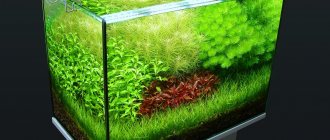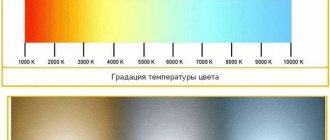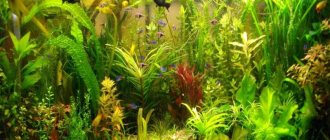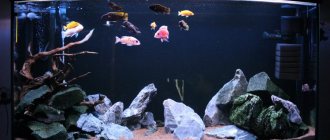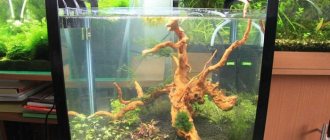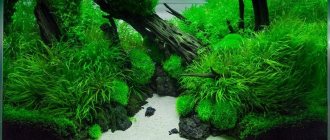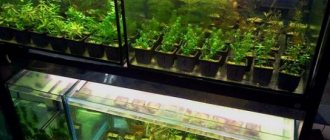There are many unpretentious aquarium plants that look interesting and impressive, like more capricious species. With the help of undemanding vegetation, a novice aquarist can create atmospheric landscapes, showing his imagination and creativity.
Unpretentious aquarium plants
Unpretentious species are distinguished by endurance and the ability to survive at different temperatures. Some of the species presented do not need a lot of light and the composition of the water is not important. Most unpretentious species grow quickly, propagate easily and do not require fertilizer.
Java moss
To propagate decorative Java moss, it does not require rooting in the ground. The unpretentious bryophyte floats freely in the water column or attaches to rocks. In an aquarium, Java moss grows quickly even in moderate light, so periodically trim the overgrown branches.
Riccia
Another popular moss. Floats above the water surface and does not require rooting in the ground. Many fish eat riccia. The plant is also loved by the microorganisms on which the fry feed. Riccia creates shaded areas in the aquarium; if desired, it can be mounted on walls or stones. The overgrown moss settles to the bottom under the weight of the moss.
Thailand fern
The Thai wing fern does not like intense light. It grows slowly, adding one leaf per month. The Thai fern does not need to be placed in the ground; it is attached to the stones by rhizoids. Provide a temperature of 24 degrees.
Indian fern
An unpretentious plant that floats on the surface or is planted in the ground. When leaving the Indian water fern above water, make sure the light does not burn the leaves. Ferns love sand or shallow soil.
Cladophora
The algae forms a colony in the form of a fluffy green ball. The unpretentious cladophora retains its spherical shape at a temperature of 23–25 degrees. Microorganisms multiply in algae thickets - food for fry and shrimp.
key moss
In modern aquarium keeping, key moss is rare. Grows successfully in cold- and warm-water aquariums. Unpretentious to light intensity.
Vallisneria
An unpretentious plant that does not require a lot of light, and the range of permissible temperatures is quite wide (5–30 degrees). It grows quickly. Popular species: spiral vallisneria and giant. Plant the grass in soil with a diameter of 3–5 mm. If there are metal decorations in the aquarium, be careful, Vallisneria does not tolerate metal oxides. Do not place in the same container with hornwort.
Hornwort
A plant with a long stem and oblong leaves. It is planted in the ground or remains in the water column for free swimming. Periodically thin out the hornwort or introduce fish that eat it.
Nayas
Easily reproduces, creating dense thickets. Often used as a hiding place for small fish. Nayas receives the substances necessary for growth from the water column, so there is no need to plant it in the ground.
Elodea
Bright green leaves form on a long stem. The plant is unpretentious to the composition of water and light levels. Elodea prefers water temperatures up to 28 degrees. It has a high growth rate. Able to grow without rooting in the ground, under good conditions it grows up to 2 meters.
Kabomba
The grass is notable for its interesting fan-shaped leaves. Easily propagates, forming a lush bush. Roots in the ground. The optimal water temperature is 20–25 degrees. Photophilous and unpretentious, it usually turns yellow in the shade.
Limnophila indica
An unpretentious plant that is planted in the ground. Leaf color ranges from reddish to green. Many thin leaves grow on long stems, giving the greenery an unusual appearance. If Limnophila is planted in a recently started aquarium, it will need nutritious soil. In favorable conditions it blooms with purple flowers above the surface of the water.
Bacopa carolina
A long-stemmed plant with rich green leaves. With a lot of light, the leaves take on a pink tint. Grows at a temperature of 22–28 degrees, planted in the ground. Flowering is accompanied by bluish flowers.
Cirrus
Very popular among aquarists since the last century. Also known as urut. In aquarium keeping, the most unpretentious species are used: Brazilian and Christmas tree. The feather-like leaves are clustered around the stem and are blue-green to gray-green in color.
Ludwigia
An unpretentious plant with a long stem and leaves that change color when exposed to light. In low light the leaves are dark green. To color the leaves bright red, choose intense lighting and fertilizers with nitrates and phosphates. Ludwigia grows quickly and reproduces easily.
Alternanters
Unpretentious varieties of alternanthera, popular in Dutch aquariums: sessile, purple, pink. Grows under and above water. In water, large leaves grow densely; when growing on the surface, they form white flowers.
Anubias
Popular species: dwarf Anubias, whose size allows it to be placed in nano-aquariums. Anubias is unpretentious to the level of light; moderate lighting is suitable for it. Dense leaves are more difficult to damage by fish and snails. Greens don't care about water parameters. It grows slowly.
Duckweed
An unpretentious floating plant. Located on the surface of the water, it creates shaded areas in the aquarium. Some water inhabitants eat duckweed, so when releasing fish, find out what they eat. To create landscapes in an aquarium, secure duckweed to driftwood using a net.
Schisandra
Known as nomaphyla recta. Bush with large yellow-green leaves. As it grows, lemongrass floats to the surface and blooms with a pronounced honey aroma. Place lemongrass in a large aquarium. Hygrophylla compacta, which is similar in color and shape, is also known as Schisandra.
Rotala
Many types of rotala have been developed. Popular red varieties: butterfly, motley, Indian. Planted in a sandy substrate with the addition of clay. With a lack of light, it loses saturation.
Staurogyne repens
A relatively new plant in the aquarium hobby. It reaches a height of 10 cm, has small oval leaves, which allows it to be kept in a nano-aquarium.
Marsilia
It grows slowly and reaches small sizes. The leaves resemble clover. Unpretentious to light level and temperature.
Cinema
Known as Hygrophila demorphus. It grows and reproduces quickly and has a well-developed root system. The yellow-green leaves are oval, serrated and lacy. In favorable conditions it forms pink inflorescences. Purifies water from nitrogenous compounds. Suitable for aquariums of all sizes.
Naiad
Grows in soil and in water columns. Thread-like leaves provide shelter for fish. Depending on the species, the leaves are brown, green or reddish. When placing grass in the aquarium, take care of the lighting; the naiad is unpretentious to other parameters.
Echinodorus
There are many species of Echinodorus that require varying levels of care. An unpretentious Amazonian Echinodorus that easily adapts to different conditions. Bright blades of grass grow from one rosette, quickly forming beautiful bushes.
Echinodorus blechera (yarrow) is just as unpretentious, similar in appearance to the Amazonian. It was bred artificially. It grows exclusively under water. Remember that this tough-leaved plant loves bright light.
Limnobium
Outwardly, this unpretentious plant resembles a water lily with a diameter of 3 cm. Long roots serve as shelters for fish and filter water by retaining and absorbing organic particles. Loves a lot of light and grows in a wide range of temperatures.
Sitnyag
Other names: Eleocharis, needle mire. The leafless stems form dense thickets and are especially good as hiding places for fish. Loves bright lighting, is not picky about other parameters.
Hydrocotyla
It grows in soil, on the surface of water, and also outside the aquatic environment. It provides shelter and a source of food for aquatic life. Hydrocotyla leaves are round and look interesting and unusual in an aquarium. Provide the plant with sufficient lighting levels.
Heleocharis
The plant resembles Echinodorus and grows somewhat thinner. Reacts to water movements, attracting attention. It reproduces by lateral shoots and grows in the direction of greatest light.
Cryptocoryne
Different types of cryptocoryne differ from each other in shape, color and size. Ribbon-shaped or oval leaves grow from a single point; there is no stem. Adapts to any water parameters. Avoid sudden changes in water parameters; greens are sensitive to sudden changes. Cryptocorynes are able to grow above water.
Arrowhead
The plant consists of narrow blades of grass 10–15 cm long. It grows in bunches. It reproduces by shoots and quickly forms thickets. The aquarium may be deficient in iron, which is indicated by yellowing of the plant. Easily adapts to different temperature and hydrochemical conditions. Grows in fresh and brackish water. If properly cared for, a blue or white flower appears above the surface of the water.
Krinum
Fast growing bulbous plant. It is highly durable, so it will be more difficult for fish to damage it. Planted in the ground so that the bulb protrudes by two-thirds. This method of planting will reduce the risk of rotting. Unusual long blades of crinum grass transform any aquarium. In good conditions, flowering occurs, producing a white flower.
General characteristics of long stemmed plants
Plants adapted for growing in aquariums and paludariums are perennial crops. All hydrophytes consist of single or weakly branched stems, along which leaves are located in pairs or whorls. Long-stemmed varieties look most advantageous when planted in dense decorative groups with at least 8-10 shoots.
Picturesque islands of greenery located along the back or side wall of the aquarium perform several functions simultaneously:
- They make the underwater landscape attractive.
- They create the illusion of depth and volume in the aquarium.
- They serve as a spawning ground or shelter for fry and peaceful fish.
- They mask filters, heaters, tubes and other equipment.
- They take part in metabolic processes, purify water from harmful impurities and organics, release oxygen and absorb carbon dioxide.
All tall species have a common drawback: they tend to leave the reservoir and grow until the leaves are above the surface of the water. When crops outgrow and continue their development in an above-water or floating form, the lower part of the stems becomes bare and loses its decorative effect.
Therefore, in the care of all long-stemmed perennials, the main attention is given to their regular cutting and rejuvenation - rooting the cut tops in the ground.
The general principle of reproduction is as follows:
- When the top of the plant just reaches the surface of the water, the stem should be cut at a level of 4-5 cm from the ground.
- If part of the shoot has already shed its leaves, then the exposed area must be removed, and the leafy top should be planted next to the “stump” remaining after pruning. If the plant has retained its foliage, the cut shoot can be rooted without shortening.
This approach will make it possible to maintain the attractiveness of tall hydrophytes for a long time and to obtain planting material for propagation or sale.
Care
Unpretentious plants require simple care:
- water change;
- pruning overgrown branches;
- removal of rotting and damaged parts;
- application of fertilizers.
Partially change the water and thin the plant once a week. Do not replace large amounts of water unless necessary; it is enough to fill up to 25% of the aquarium volume. Combine fluid changes with soil siphoning. Siphon the soil carefully near the roots, using special small nozzles so as not to damage the plants. Apply fertilizer as needed, no more than once a month. Be careful with dosages.
Typically, unpretentious flora does not require additional fertilizing; green plants are sufficiently nutrient-dense in the water. Monitor the light intensity and color spectrum. When using fluorescent lamps, change them on time.
Popular types of plants for the background
Pet stores offer a large selection of aquarium plants to decorate the background of the aquarium. But to create “living” scenery, it is enough to purchase 3-5 varieties with the same requirements for water parameters, lighting and soil composition. The optimal companions in this regard are bacopas, hygrophides, ludwigias, cabombas and ambulias. They can be grown in aquariums of different shapes, sizes and volumes - from 40 to 300 liters.
Bacopa
The group of unpretentious plants includes about 100 species, but no more than 5 varieties are used in aquarium keeping. Representatives of the genus have erect, lodging or creeping stems, on which broadly elliptical, lanceolate or ovate leaves are alternately placed. The natural color of hydrophytes is green; in some varieties, shoots and leaves can be colored in yellow, pink and red shades.
Bacopa for aquarium
The most widespread in artificial reservoirs are:
- Bacopa carolina. The green leaves arranged in pairs reach 2-2.5 cm in length. With sufficiently intense lighting, it quickly grows in breadth. Developing outside the aquarium, it can bloom with blue bell-shaped flowers. Not suitable for growing in large aquariums. The maximum depth at which the hydrophyte should be planted is 20-30 cm.
- Bacopa australis. Opposite leaves are colored pinkish-greenish. Adult specimens grow up to 40 cm, so they can be kept in deep aquariums.
- Bacopa Monnieri. Erect or creeping stems up to 40 cm long form lush bushes, strewn with pairs of fleshy leaves of almost round shape. Even under relatively unfavorable conditions, the variety retains its cheerful bright green color.
- Bacopa Madagascar. The length of the shoots does not exceed 15 cm. Hydrophyte purifies water well and inhibits the development of weeds.
Bacopas feel best in greenhouse conditions - humid greenhouses or paludariums.
If necessary, they easily adapt to the underwater lifestyle, do not shed aerial leaves, and do not suffer from a coating of organic or mineral particles covering the stems and leaf blades.
| Conditions for growing bacopa | |
| Temperature | +20…+28°С |
| Rigidity | 6 – 8°F |
| Acidity | 6,5-7,5 |
| Weekly water change | 20-25% of the total volume |
To grow a hydrophyte, you need bright light - scattered rays of the sun or lighting with fluorescent lamps. The minimum daylight hours are 10 hours. Under unfavorable conditions, bacopa stops developing and begins to hurt. The leaves of the plant suffer from high hardness, lack of lighting or low temperature - they become deformed and rot.
Bacopas reproduce by rooting cut tops or dividing the mother bush, which consists of several shoots. Sand or small pebbles laid in a layer of 2-4 cm are suitable for planting the plant.
Kabomba
The reservoirs of America gave the world a numerous genus of cabombas - aquatic plants with flexible, few-branched shoots and fan-shaped, finely dissected leaves. Openwork leaves sway from the slightest current and give the underwater landscape a special attractiveness. In pet stores you can find varieties with green, pinkish or reddish coloring of stems and leaves.
The most popular representative of the genus is the Carolina cabomba. Its openwork light green leaves participate in metabolic processes occurring inside the aquarium - they absorb organic debris, harmful impurities, and particles of mineral compounds. In natural biotopes, hydrophyte shoots can reach 2 m in length. In an aquarium, the stems grow up to 35-40 centimeters or more, giving an increase of 5-10 cm per month.
Cabombas are unpretentious. They look elegant both in single plantings and in combination with other representatives of aquaflora. The soil for the aquarium in which the cabomba is located should consist of dark, coarse sand or small pebbles.
| Conditions for growing cabomba | |
| Temperature | +18…+27°С |
| Rigidity | 2 – 8°F |
| Acidity | 5,5-6,8 |
| Weekly water change | 20-25% of the total volume |
| Lighting | 0.5 W/l |
| Length of daylight | 10-12 hours |
All varieties of cabomba are easily propagated vegetatively:
- apical shoots at least 2-3 cm long;
- part of the stem with 5-6 whorls of leaves;
- fragments of rhizome with 1-2 growth buds;
- dividing the bush.
Cabomba for aquarium.
When planting, the cuttings need to be buried so that 2-3 pairs of leaves are in the soil. Successful rooting of planting material can be judged by increased growth or the appearance of new side shoots. Trimming or pinching the tops will help speed up the formation of root shoots and enhance the bushiness of the cabomba.
Hygrophiles
Of all the existing species in the aquarium hobby, Hygrophila polysperma is most often used. Its shoots grow up to 50 cm, the elongated oval leaves of the plant are colored rich green and are arranged in pairs along the stem. No less common is hygrophila patterned, or marbled, with pink-ruby or pink-green leaves covered with bright veins.
Hygrophila plants are a suitable choice for beginner aquarists. These unpretentious plants grow green mass throughout the year (3-4 cm per week), are distinguished by their attractive appearance and undemanding conditions.
| Conditions for growing hygrophila | |
| Temperature | +18…+30°С |
| Rigidity | 2 – 8°F |
| Acidity | 7,0-7,4 |
| Weekly water change | 20-25% of the total volume |
| Priming | Small pebbles or sand |
As with other long-stemmed plants, lighting plays an important role for hygrophila. The power of fluorescent lamps should be at least 0.4-0.5 W/l, and the duration of daylight hours should be 10-12 hours. Lack of lighting can cause a decrease in the size of the leaf blades and a loss of decorativeness of the perennial.
It is recommended to keep Hygrophila in tanks with a volume of more than 50 liters. The best option is to place green groups of hygrophiles in a 100-200 liter aquarium.
In nanoaquariums, this fast-growing species can quickly fill the free space and displace other aquatic cultures. From time to time, green thickets need to be pruned and thinned, removing old shoots that have lost their decorative properties.
Limnophils, or ambulia
The aquatic plant of the Norichaceae family has two botanical names - limnophila, or ambulia. The hydrophyte is given a special decorative appearance by pinnately dissected leaf plates, whorled along the stem. In each whorl, from 3 to 10 light green leaves are formed, the height of adult specimens is 40-50 cm. It is recommended to plant Limnophila in the background in a group, the minimum volume of the aquarium is 100 liters or more. The plant “feels” volume well: in large tanks it grows by 3-5 cm per week, and in cramped containers it grows much more slowly.
| Ambulia growing conditions | |
| Temperature | +22…+28°С |
| Rigidity | 3 – 15°F |
| Acidity | 6,0-7,5 |
| Weekly water change | 20-25% of the total volume |
| Priming | Small pebbles or sand |
| Light intensity | 0.5 W/l |
| Length of daylight | 10-13 hours |
When growing hydrophytes, high-quality filtration is of great importance. In muddy water, openwork leaves quickly become covered with plaque and organic debris, which causes the ambulia to lose its attractiveness and slow down metabolic processes in the surface tissues. To stimulate growth, it is useful to regularly feed the plant with carbon dioxide and complex mineral fertilizers - liquid or in the form of root tablets.
Limnophila is propagated in the same way as other long-stemmed crops - by fragments of the stem, cut off shoot tips or division of the rhizome. All care and propagation manipulations should be performed with caution: fragile stems may suffer from strong mechanical stress.
How many plants can there be?
When choosing the right number of plants, consider:
Some fish are more comfortable being around a lot of greenery. Some aquarium inhabitants eat and dig up plants, others are indifferent to the aquarium flora. With high-quality filtration and aeration, plants will need less. Take these features into account when filling the aquarium with grass.
The choice of style also plays an important role. For example, the Dutch style involves a large amount of greenery, in which not a single piece of soil is visible.
A universal rule for settling: there should be no more than a third of the area of the aquarium with greenery.
For each plant, find out its requirements, as well as how the inhabitants will relate to this type of plant - whether they eat it or dig under it.
Decorative purpose
Consider the needs of aquatic inhabitants and the interior of the room. Think about the composition in advance. There are several rules to help create a spectacular pond:
The background
Unpretentious plants, most suitable for decorating the background:
Center
Place in the center:
Foreground
Place a small and bright flora in front:
Plants of other colors
Dilute the greens with scarlet and purple shades:
To ensure rich colors, you will need fertilizer. Sufficient illumination remains the decisive factor.
The procedure for planting plants in an aquarium
Before planting, it is advisable to empty the aquarium of water. First, the vegetation is attached to large stones located at the bottom of the aquarium, or driftwood, locks, or ceramic figurines. Mosses or ferns look best on driftwood and stones.
To prevent the plant from floating, nylon threads are used for fastening. After some time, this material dissolves on its own, and the plants naturally attach to the decorative elements.
Moss can be attached using a thin transparent fishing line, which after a few weeks becomes overgrown with greenery and becomes invisible to others. The abundance of different plant species is impractical, especially since growing conditions may vary.
Foreground scenery
Plants planted along the front line can present the aquarium at its best. They should look impressive, but not cover up the rest of the beauty. You can decorate the foreground with the following plants:
- Echinodorus tenellus
Its special ability to acquire different colors (green, red, purple) is successfully used by aquarists. The bush plant at home does not grow higher than 10 cm; the width of the leaf blades is about 5 mm. In unsuitable conditions, Echinodorus inhibits growth and stops at 5 cm. It grows even without the addition of fertilizers and does not have any special requirements for lighting. The color of the leaves depends on the degree of illumination. With minimal illumination, the leaf blades remain green, but if the indicator is increased (up to 1 W/l), the shade changes from golden to red or purple. An interesting feature of the plant is that it changes the shade of its leaves depending on the acidity of the water. If the pH is less than 7, the leaves delight with an emerald hue; as the pH increases, the color of the foliage changes, it becomes reddish. At elevated pH, a reddish-purple color can be achieved. Caring for Echinodorus involves periodically trimming the long lateral shoots and thinning the plant carpet. - Eleocharis, or tiny blueberry
It fully lives up to its name. The dimensions of Eleocharis do not exceed 10 cm. Sitnyag is considered a bush plant with needle-like leaves. In summer, the water temperature should not rise above +24°C, but a decrease to +19°C is also unacceptable. In winter, +16°C is sufficient for plants. Any lighting can be used. The role of artificial light is played by fluorescent lamps. Natural substances should not fall directly on the plant. By planting several bunches along the front line of the aquarium, after a few weeks you can get a beautiful carpet of light green color. The cutting procedure allows you to give the plant the appearance of lawn grass. Sitnyag needs to clean the soil and add fresh water. - Cryptocoryne wendtii
Borrowed from swampy Asian regions. It will be able to decorate a large aquarium, since with proper care it grows up to 22 cm. The small volume of the aquarium leads to the formation of small bushes. The temperature is maintained at +26-28°C. With a reduced rate, the bushes slow down their growth. The plant is undemanding when it comes to water transparency, but when the acidity in soft water changes, it reacts by shedding its leaves. Direct sunlight is poorly tolerated, otherwise the plant does not require light. Lighting must be present for 12 hours a day. Feeding is not important, but the plant has some requirements for the soil. A sand-pebble mixture is used, with the addition of additional components: clay, peat, silt. The root system has a powerful structure, so a five-centimeter soil thickness is the minimum condition. Overgrown bushes are propagated by dividing the rhizomes; you can separate small bushes that have 2-3 leaves. - Anubias nana
This culture does not grow higher than 15 cm. The aquarium plant has a wide leaf plate, painted green. Anubias loves shaded areas of the aquarium and, in suitable conditions, creates compact thickets that can decorate the foreground of the aquarium. Water for the plant should be clean and soft. Comfortable conditions include a summer temperature of about +25-26°C; to create vegetative dormancy in winter, the temperature is reduced to +20°C. A significant reduction can lead to plant death. You can propagate the plant at home. The method of obtaining new seedlings is vegetative. - Lileopsis
Forms dense green thickets in the foreground. Belongs to the celery family, has lanceolate-shaped leaf blades, does not exceed 6 cm in height. By increasing the lighting of the aquarium, you can increase the density of the green carpet. The plant develops very slowly. Unpretentious to the following indicators: water temperature, acidity and hardness. The only condition that must be met is sufficient lighting.
Plants for the background
The tallest plants are suitable for decorating the background. Beginner aquarists are advised to choose undemanding plants:
- Indian fern
An aquarium culture can grow in the ground or float freely on the surface. Sand or small stones are chosen as a comfortable soil. If the plant floats unattached, it is necessary to protect it from being burned by a lamp. - Thailand fern
It grows quite slowly, producing a new leaf once a month. For this type of fern, a shady area and a comfortable temperature above +24°C should be provided. The plant does not have to be buried in the ground; it is enough to fix it on stones with the help of rhizoids. - Cottonwort (hydrocotyl)
This is a common representative of tropical aquariums. A decrease in temperature leads to slower growth. The plant is not capricious in terms of acidity and hardness, but at the same time it loves clean water, so regular replacement is required. The illumination indicator plays a huge role. Lack of sunlight leads to poor growth and even death of the plant. Daylight hours should last at least 12 hours. The plant is propagated by cuttings. - Nomaphyla straight
An introductory culture can harmonize the background of the aquarium. This beautiful plant, which is called lemongrass, is unpretentious in maintenance, therefore it is often used by beginning aquarists. It grows as a dense bush; to improve growth, the stems are shortened. In small aquariums, the plant stops growing, but the appearance remains good. The plant is more suitable for tropical aquariums, as it does not like cold water. Lighting must be of high quality, at least 0.5 W/l. You can place the aquarium closer to a source of natural light. - Cabomba furcata
It has a fibrous root system and an elongated, weakly branched stem that spreads along the surface of the water. The reddish tint of the plant allows you to diversify the picture of a green aquarium. The height of the plant can reach 40 cm, which is suitable for medium-sized aquariums. Necessary conditions: temperature +25-28°C, clean water and 12 hours of light throughout the day.
Central plan decoration
The bottom of the aquarium should be decorated harmoniously. The following plants are chosen for the central plan:
- Vallisneria
A perennial plant that adapts to any conditions in the aquarium. Vallisneria comes in different types: spiral, simple, giant. The plant develops well with sufficient lighting, so daylight hours should last at least 15-16 hours. When growing, it is necessary not to cut off the foliage, but to reduce the number of plants. - Ferns
Ferns can not only decorate the far corners of the aquarium; they can be placed in the center for everyone to see. - Echinodorus "Isabella"
Refers to Polish hybrids. The shape of the plant is rosette, the leaves are lanceolate, the shade of the leaves depends on their age and conditions of detention. Young shoots have a bright crimson or red color, and old foliage pleases the eye with all shades of green. Good lighting and nutritious soil promote the rapid growth of Echinodorus. The plant does not cause any difficulties in care, even for novice aquarists. - Cinema
Suitable for decorating an aquarium of any type and size. The plant is thermophilic, so it feels comfortable in water whose temperature is about +25-26°C. Diffused daylight is most suitable for the plant; the duration of illumination per day should be about 12 hours. Coarse sand mixed with clay is needed as soil. Propagation is carried out by cuttings or dividing the stem.
